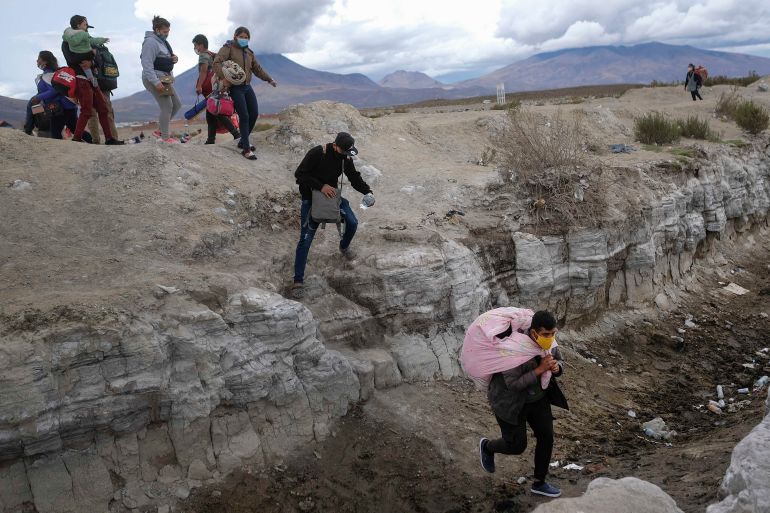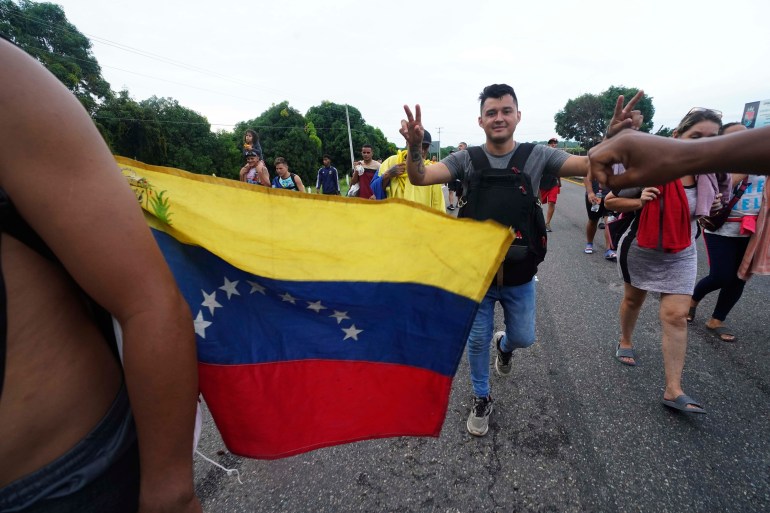Over 6.8 million have left Venezuela since 2014 and exodus grows
At least 753,000 Venezuelans have left the country since November, according to data from receiving countries.

About 6.8 million Venezuelans have left their homeland since an economic crisis took hold in earnest in 2014 for the country of some 28 million people. Most have gone to nearby nations in Latin America and the Caribbean. More than 2.4 million are in Colombia.
That huge migration slowed as the pandemic cut economic opportunities and complicated travel across the region and as Venezuela’s socialist government adopted reforms that slowed the country’s economic free-fall and gave some appearance of revival.
Keep reading
list of 3 itemsUS court backs Conoco’s $8.7bn award for seized Venezuelan assets
Colombia, Venezuela restore full diplomatic relations
Approximately 150,000 Venezuelans returned to their homeland at the height of the coronavirus pandemic, according to United Nations estimates, and some host countries reported a decline in the overall count of Venezuelan immigrants for the first time in years.
But the outward march is on the rise again.
Venezuelan🇻🇪 migrants and refugees defy deadly desert🏜 conditions on their journey to Chile🇨🇱.
Often in small groups, exhausted people are on the move along one of the most extensive migration routes in the world🌎.
Learn about their stories👇🏼
🔗https://t.co/D6tnw5NSnO pic.twitter.com/NLRDj0gw3K— OIM Resp. Refugiados y Migrantes de Venezuela 🇺🇳 (@OIM_RRMV) August 31, 2022
At least 753,000 Venezuelans have left their country for another in Latin America or the Caribbean since November, according to data from receiving countries, even as the government of President Nicolas Maduro has continued to tout economic growth. Colombia, which had not reported updated figures since November, posted a jump of roughly 635,000 between that month and August.
Pandemic lockdowns and border closures also have pushed Venezuelans to riskier paths. Mexico recently imposed a visa requirement for Venezuelans, so instead of flying to a country bordering the US, Venezuelan migrants now often trek northward across Central America after crossing the Darien Gap, a roadless jungle straddling the Colombia-Panama border where thieves, swollen rivers, rough terrain and wild animals are common.
Panama’s government said 45,000 Venezuelans had entered its territory that way so far this year, up from only 3,000 last year.
The lack of diplomatic ties between the US and Venezuela has meant that the US has been unable to expel Venezuelans under a pandemic-era rule on the US-Mexico border. The US has allowed some Venezuelans to apply for asylum, and in July, the administration of US President Joe Biden extended Temporary Protection Status for Venezuelans in the US since before March 8, 2021, shielding some 343,000 people from deportation for an additional 18 months.
Still, the future for Venezuelan asylum seekers in the US is fraught amid pressure from Republican officials who have seized on the growing number of migrants arriving at the border to assail Biden’s policies on migration and border security.
Arbelys Briceno was on her eighth day on a journey from her Venezuelan hometown to Peru, a country the 14-year-old could not place on a map but that her older brother had set as their destination. Mosquitoes had marked her legs. The sun had baked her face.
“It is as if it were a vacation but with lots of walking,” Arbelys said with an outlook far more upbeat than that of most Venezuelan migrants trying to escape poverty in their once-prosperous country.
As I said it some weeks ago, once the R4V platform updated the numbers in Colombia, they would increase considerably. As of August 2022, there are 6.81 million Venezuelan migrants and refugees from Venezuela. In Costa Rica, Panamá, Curacao and Brazil they also increased. pic.twitter.com/E8auz1ZI0v
— María Gabriela Trompetero🇺🇦 (@GabyTrompetero) August 29, 2022
By the time Arbelys, her sister and their brother reached Colombia, they had walked about 600 kilometres (370 miles). She had been unable to sleep one night – they had stayed on a sidewalk and she was startled by noises. She slipped and fell twice as they walked along a muddy back road to cross the border.
Her brother, on the journey for a second time, knew better than to allow the harsh sun to crisp his skin and slathered his face with sunscreen, which had formed streaks on his forehead.
Data compiled by the Interagency Coordination Platform for Refugees and Migrants, which involves about 200 humanitarian organisations, show governments have recorded the arrival of 753,000 Venezuelan migrants, refugees and asylum seekers since November in 17 Latin American and Caribbean countries.
The platform’s data also show the overall population of such Venezuelans in those countries had declined slightly for a time last year, from 4,620,185 in January to 4,598,355 in July.
The platform’s figures do not include all migrants as some countries do not count those who are illegally present and they do not include figures for other countries, such as the US.

Outside the soup kitchen in Los Patios, about 7.5km (4.5 miles) inside Colombia, people quickly cram around an outdoor table once the chain link fence door opens.
Some had learned from friends or other migrants about the operation, whose cooks prepare upward of 40 gallons (151 litres) of soup for each meal at two sites.
Jhon Alvarez, coordinator of the Fundacion Nueva Ilusion — roughly New Hope Foundation in English — said he is increasingly seeing familiar faces at the soup kitchen.
“People are returning from the other countries — Chile, Peru, Ecuador, Bolivia — again to Venezuela, but after 15 days or a month they can’t stand it, and they come back,” Alvarez said.
He said they tell him, “’Look, I had to come back because the situation is still the same [or] it’s worse. They raised the minimum wage, yes they did, but there’s no work.’”
Nowadays, 48 percent of migrants surveyed by a network of assistance agencies cited lack of employment and low salaries as their main reason to leave Venezuela, while 40 percent mentioned difficulties obtaining food and basic services, according to the Venezuelan office of the UN High Commissioner for Refugees.